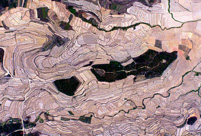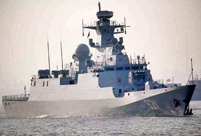

BEIJING, March 18 -- The largest nuclear security center in the Asia-Pacific region, which was financed by China and the United States, opened Friday in Beijing, according to authorities.
The center, constructed by the China Atomic Energy Authority (CAEA) and the U.S. Department of Energy, has the capacity to train about 2,000 nuclear security staff from China and other Asia-Pacific nations each year, said CAEA director Xu Dazhe.
The center is the largest nuclear program to receive direct Chinese and U.S. government funding. Construction began in December 2013.
According to the CAEA, the site will become a center for international exchanges and cooperation on nuclear security, the demonstration of advanced technology, testing and analyzing.
The center is a significant achievement in China-U.S. nuclear security cooperation, and will boost cooperation in the Asia-Pacific region and the world, said Wang Yiren, deputy director of the CAEA.
It will also promote the peaceful use of nuclear power, added Wang, who is also deputy head of the State Administration of Science, Technology and Industry for National Defence.
China and the United States agreed to establish a nuclear security center at the Nuclear Security Summit in Washington in 2010.
Under the agreement, the center, which is located in Fangshan District, Beijing, is run and administered by China, while the United States is responsible for providing nuclear-security equipment.
The two nations have also cooperated in other nuclear security areas such as low-enriched reactors, security of radioactive sources and radiation detection by customs authorities, according to Wang.
The Chinese mainland has 30 operational nuclear power generating units, with a total installed capacity of 28.31 GW. It also has 24 units with a total installed capacity of 26.72 GW under construction, ranking first in the world.
As planned, the nation's installed nuclear power capacity will reach 58 GW with an additional 30 GW under construction by 2020.
"Construction projects for six to eight new generators are expected to begin each year from 2016 to 2020," Wang said.
He also said China was mulling building of offshore floating nuclear power stations.
Earlier in January, the central government published a nuclear white paper detailing policies and measures relating to nuclear emergency preparedness and highlighting a "rational, coordinated and balanced" approach to nuclear security.
The document assured the world that China had "the most advanced technology and most stringent standards" to ensure safe and efficient development of nuclear power.
 Thai most beautiful transgender Nong Poy release new photos
Thai most beautiful transgender Nong Poy release new photos Now and then photos of Shanghai Jiaotong University
Now and then photos of Shanghai Jiaotong University Is this what air travel will look like in 2050?
Is this what air travel will look like in 2050? Aerial view of watermelon terraces in S China's Baise
Aerial view of watermelon terraces in S China's Baise Traditional wedding of a post-80s Tibetan couple
Traditional wedding of a post-80s Tibetan couple Models in cheongsams present classical oriental beauty
Models in cheongsams present classical oriental beauty Second commissioned C28A corvette made by China enters Algerian Navy
Second commissioned C28A corvette made by China enters Algerian Navy Intoxicating Wuyuan in spring
Intoxicating Wuyuan in spring Gold and silver wares of Qing Dynasty exhibited in Shenyang Imperial Palace
Gold and silver wares of Qing Dynasty exhibited in Shenyang Imperial Palace Top 20 hottest women in the world in 2014
Top 20 hottest women in the world in 2014 Top 10 hardest languages to learn
Top 10 hardest languages to learn 10 Chinese female stars with most beautiful faces
10 Chinese female stars with most beautiful faces China’s Top 10 Unique Bridges, Highways and Roads
China’s Top 10 Unique Bridges, Highways and Roads Not a child’s play: Kids working as adults to make a living
Not a child’s play: Kids working as adults to make a living Chinese town on North Korean border faces bleak business prospects
Chinese town on North Korean border faces bleak business prospects China set to boost access for US investors
China set to boost access for US investors Premier mollifies fears over economy
Premier mollifies fears over economyDay|Week